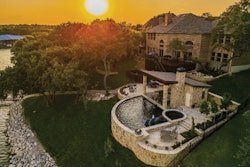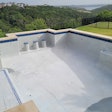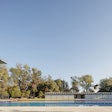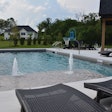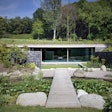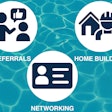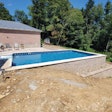Has digital design technology adapted itself to the aquatics design industry, or has the industry adapted itself to the technology? It's an interesting conundrum. The best answer is that it's almost certainly some of both.
As technology has advanced, the way designs are created, presented, sold and ultimately built has clearly evolved. By the same token, programs that target landscape and pool design have had to adapt to the challenges specific to working with water, hardscape and other features common in today's projects, as well as ever-evolving consumer expectations.
For the purposes of this discussion, we'll look at how the technology has impacted the industry through the lens of one of the industry's true innovators, Noah Nehlich, founder of Structure Studios. Structure Studios is the force behind Pool Studio, a program that has rapidly gained acceptance since its introduction in 2005.
CREATIVE RESPONSE
"Technology has transformed how things are run from design through construction," Nehlich says. "It's changed how clients perceive the buying process. We believe it changes how clients ultimately are presented with the project they buy and gives builders tools that help them manage the process of making those concepts real."
Starting with the design process, Nehlich asserts that the speed and ease afforded by technology has enabled many builders to expand their designs into areas they hadn't previously attempted. As such, today's design technology helps builders quickly adapt to changing market conditions.
"We've seen a lot of natural convergence of landscapers venturing into pools and pool builders venturing into new areas," he says. "We first really noticed it around the recession during the housing crash. Prior to that, most pool companies that would come to us wanted to build a pool, deck and fire pit, tops. Many didn't really want to focus on anything that was outside of their realm. Sure there were outliers who were expanding, but for most the focus was relatively narrow. But once the housing crash happened, the number of clients who could still finance a project was very small."
Nehlich recalls how many builders using digital design software lowered their minimum project price levels down to as low as $5,000 just to get their foot in the door with cash-strapped homeowners who could later afford bigger projects once the real estate market rebounded. As housing prices rose post-recession, the strategy worked.
"The inventive companies would build only an outdoor kitchen, but they would design out the entire yard in phases," he recalls. "Even though you might start out selling just a part of the design, you can use the technology as an engine to address the customer's lifestyle beyond the initial sale. When customers can see the entire project in 3-D, a $5,000 job can eventually became a $120,000 job."
RELATED: The Digital Design Evolution
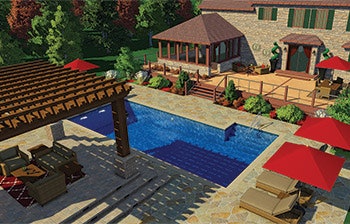 It's not just the water: Digital renderings now include the entire setting, including outdoor kitchens, fire features, patio furniture, shade structures, landscaping and the house itself.
It's not just the water: Digital renderings now include the entire setting, including outdoor kitchens, fire features, patio furniture, shade structures, landscaping and the house itself.
PRESENTING POSSIBILITIES
By accelerating the design process, while at the same time making it easy to expand designs to include an almost endless range of features, builders have been able to quickly and easily present ideas that their clients oftentimes hadn't yet considered, or even realized were available.
"It's not unusual for progressive companies that we know to often shoot for a 20 percent upsell on the project," he explains. "They'll add extra features just to show the customers what they could have because oftentimes, the customer is not really the ultimate expert about what will make them happy. The technology makes that easy because you can always change the plan very quickly. The builder will put in a putting green and a fireplace, just show them what they could have. When the customer sees that, it might spur some ideas of their own, or they might just want to have it edited out. Either way, it can be done right in front of them."
 Among the many advances in design programs, the ability to capture the complex interplay of light and water adds a level of dramatic realism in both night and daytime settings.
Among the many advances in design programs, the ability to capture the complex interplay of light and water adds a level of dramatic realism in both night and daytime settings.

That level of flexibility and immediacy has facilitated a level of interaction that gives the client a sense of participation, which strengthens their attachment and commitment to the design.
"When customers can make decisions like that on the fly, in the moment, it builds an emotional connection with the project," he says. "It's like if you buy an IKEA table versus building it yourself. You'll feel much better about it if you build it. It facilitates collaboration with the client."
Exactly how that process unfolds tends to break down into two basic categories, Nehlich explains. About half of those using Pool Studio report that they prefer generating the initial design in the client's home, giving the homeowner the immediate excitement of direct participation. The other half prefer to bring the client into their office or studio where they sit through a pre-prepared presentation, giving them the "big reveal" moment.
Either way, he says, the speed and immediate flexibility of the design gives the builder a way to rapidly bond with the homeowner and generate excitement that will ultimately motivate them to purchase the project.
"The most important thing is that we save the designer time throughout the process," he says. "We labor over lots and lots of details to make everything as automated as we can because time is always an absolute premium. That's true whether it's about saving time drawing, working with the client or managing the construction crews to build what they envisioned."
KEEPING PACE
One of the big reasons for the success of digital design platforms comes down to the fact that in the era of constantly advancing communication technology, clients expect to be "wowed" by presentations, especially so when they're considering making a sizable investment in their at-home lifestyle.
"People today value being surprised more than they ever have because there are so fewer surprises in today's world," Nehlich says. "People feel that they've seen it all and we work to overcome that all the time. When there's a reveal, a surprise, suddenly they're engaged."
RELATED: How Times Have Changed: Technology in Pool and Spa Retail
BEYOND THE SALE
Once the client has bought into the design concept, today's technology can then play an expanded role of helping the builder bring the project to fruition. Programs that generate specifications and estimates on material costs — like how much rebar, concrete, and coping will be needed — provide the ability to manage costs as well as work with subcontractors that may be hired for parts of the project.
Nehlich says that busy builders may simply rely on what subcontractors are telling them for material requirements without doing their own calculations. But with automatic estimates provided by design software, "Now they can see immediately what the project requires and in a sense hold some of their subs accountable. There's proof for what should be in the project. We've had a lot of contractors call and thank us because now they have exact numbers and specifications."
Virtual reality in digital design has given builders the ability to put clients directly into the envisioned poolscape to see if they like it. The next step in the evolution of the technology seems certain to be augmented reality, in which a design is made appearas though it's in the real world by looking through a camera onto a pad. This allows the customer to physically move around the intended space and inspect the design instead of just watch a screen.
For all of the advantages, excitement, practicality and creative flexibility of digital design technology, however, Nehlich is the first to caution that in many ways the same principles of communication — namely trust-building and responsiveness to client ideas, preferences and budget — remain the same as years before his program and others like it came along.
"We remind designers all the time that the software is merely a medium to express ideas, just like the pencil is a medium," he says. "It's a tool to open up your own creativity. You still don't want to ever pressure a customer and go too fast, because ultimately it's about building more value for them." For all of the advantages, excitement, practicality and creative flexibility of digital design technology, Nehlich is the first to caution that in many ways the same principles of communication — namely trust-building and responsiveness to client ideas, preferences and budget — remain the same as years before the digital design revolution.



























